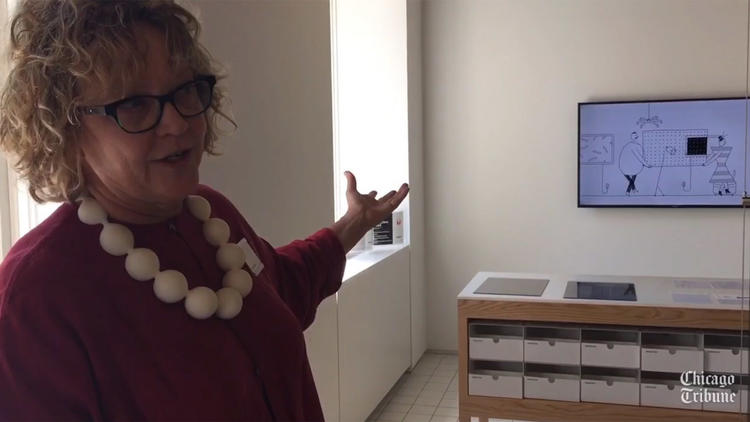The office of the future features unconventional open spaces, ergonomic
products, and — coming soon from furniture designer Herman Miller — smart chairs
and desks that track your every movement and report back to your boss.
Introduced this week at the NeoCon commercial interiors show at the
Merchandise Mart, the Fitbit for the deskbound connects office workers and their
posteriors to the internet, harvesting such data as when you sit, where you sit
and how often you rise on command to stretch your legs.
It can even tell if you're slouching, standing in for mothers everywhere by
reminding you to sit up straight.
"No one has made an interaction between a chair and a desk," said Greg
Bylsma, North American president of Zeeland, Mich.-based Herman Miller, perhaps
best known for its ergonomic Aeron chair, whose distinctive design has become an
office staple since its 1994 rollout.
The platform, dubbed Live OS, works with an interactive sitting and
standing desk, which launched this week, and a specially wired Aeron chair,
which will be available in January.
For the chair, a static discharging thread already woven into the Aeron
fabric is turned into a sensor that takes readings on seat position.
Per sitting and standing desk, the technology adds a $100 one-time hardware
cost, with a yearly subscription fee of $60. Prices for the smart version of the
chair have yet to be determined.
When paired with an app, the chair and desk will monitor your position,
automatically adjust preferred settings as you switch to other work stations and
nudge you with vibrations and cajoling messages to stand up at intervals
throughout the day.
The latest innovation in the internet of things encourages healthier desk
habits for employees while collecting new data for their employers, who can
maximize the efficiency of office space by determining where and how people
actually work — or don't.
Ryan Anderson, Herman Miller's director of commercialization for Live OS,
said the data is "anonymized and aggregated," downplaying the notion that
employers are watching your behind.
 A Live OS sit/stand desk and chair are displayed
June 12, 2017, in the Herman Miller space at the NeoCon commercial interiors
trade fair at the Merchandise Mart in Chicago. The desk and chair are designed
to monitor workers’ posture and encourage them to stand up during the workday.
(Terrence Antonio James/Chicago Tribune)
A Live OS sit/stand desk and chair are displayed
June 12, 2017, in the Herman Miller space at the NeoCon commercial interiors
trade fair at the Merchandise Mart in Chicago. The desk and chair are designed
to monitor workers’ posture and encourage them to stand up during the workday.
(Terrence Antonio James/Chicago Tribune)
"If someone wanted to look at every desk and correlate (the data) with who
sits there, they can do that," Anderson said. "The vast majority of folks we
talk to want to measure the space, not the people."
Sales of the Aeron chair, which was "remastered" last fall, have been
slumping in recent years as offices have evolved into unconventional open spaces
with communal work areas.
"What you're seeing is new modes of work popping up — hot-desking, standing
work, collaborative-type cafes," said Todd Bracher, 42, a Brooklyn-based design
strategist. "It's no more glass conference rooms, no more work stations. The
younger generation doesn't want to work in that old, gray, cold environment any
more."
The showrooms at NeoCon reflected the open-office evolution while
repudiating the cubicle farms of old, a concept that also was invented by Herman
Miller — more than 50 years ago.
"For the last 50 years, furniture companies have been giving us stuff
that's kept us sitting in cubicles, at desks and chairs that don't move," said
Robert King, founder and CEO of Humanscale, the 34-year-old New York-based
furniture company. "Now we're finding out that sitting perfectly still in an
isolated environment is one of the worst possible things you can do for your
health and well-being."
 Susan Lyons, president of Designtex, demonstrates
a window-cloaking film at NeoCon that blocks LED screens. June 13, 2017 (Robert
Channick / Chicago Tribune)
Susan Lyons, president of Designtex, demonstrates
a window-cloaking film at NeoCon that blocks LED screens. June 13, 2017 (Robert
Channick / Chicago Tribune)
Arianna Huffington, co-founder of the Huffington Post, who left the news
website in August to launch Thrive Global, a lifestyle and well-being website
aimed at ending stress and burnout, was a keynote speaker at NeoCon on
Monday.
"The connection between design and health and reducing stress is incredibly
important," Huffington said in an interview after her speech.
Huffington touted everything from standing desks to green walls as
beneficial to the modern office and its stressed-out workers. But she was most
enthused about another innovation: napping pods.
"People, if they are tired, can take a 10- or 20-minute nap instead of
having another cup of coffee and a cinnamon bun," Huffington said.
Herman Miller executives are hoping the smart desk and chair platform will
be the next big thing, but innovation sometimes can chart an unpredictable
course.
Launched with high hopes as a user-friendly modular office solution in
1964, Herman Miller's cubicle concept descended into a dehumanizing layout
parodied everywhere from "Dilbert" to "Office Space."
The cubicle eventually was disavowed by its creator, Herman Miller designer
Robert Propst.
Herman Miller's Bylsma acknowledged the cubicle's tarnished legacy but
didn't disown it, saying it provided a "great way to work" in decades past.
"We all know that 'Dilbert' has taken its fair shots at the cubicle, but
like anybody, we're proud of our past innovation," Bylsma said. "And we think
(the smart chair and desk) is another one that's going to take us to a new
spot."
Correction: An earlier version of this story gave the incorrect
subscription price for the Herman Miller sitting and standing desk.






